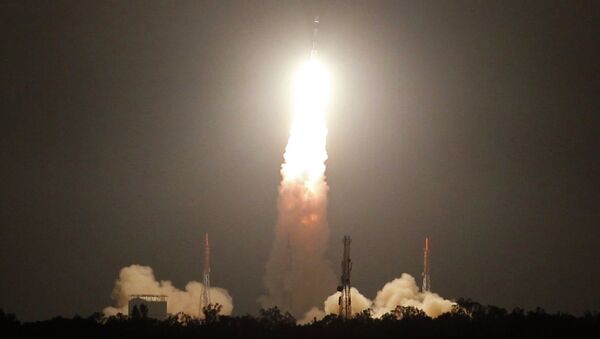New Delhi (Sputnik) — Indian Space Research Organization (ISRO) says it is working on a project to double the load carrying capacity of all its rockets. With this, the state-run space agency expects to cut heavy satellite launch costs by at least 50 percent. Presently, India's rocket can carry a maximum payload of four tons into a geostationary transfer orbit.
ISRO hopes to lower the launch cost through technologies like reusable launch vehicles and its scramjet engine, which it tested once in a mission in 2016. But, it will be ready only by the year 2030, according to ISRO chairman K Sivan.
"Our major objectives are to increase the production of rockets so as to increase the number of satellite launches; enhance our rocket's capability; look at reduction of rocket production cost; develop and realize the small rocket with a carrying capacity of 500 kg and also realize reusable launch vehicle/rocket," K Sivan, chairman, ISRO said at a function in Chennai.
READ MORE: Indian Space Agency Successfully Launches Country's 100th Satellite
GSLV MK-III is ISRO's most powerful launch vehicle to date which can lift four ton of payloads to the geostationary transfer orbit and 10-tons to the lower earth orbit. The GSLV MK-III costs approximately $60 million, which ISRO intends to further lower to garner the lucrative heavy satellite launch contracts. While a satellite launch on Arianespace's rocket costs about $100 million after subsidies, SpaceX charges approximately $62 million.
Meanwhile, ISRO has also started using electronic propulsion to reduce the weight of its communication satellites. Nearly 60 percent of the satellite weight consists of onboard chemical fuel and by opting for electric power for maneuvering in space the mass of the satellite is reduced. ISRO first tested this technology on the GSAT 9 which had its overall weight reduced by three-fourths with electronic propulsion.
India currently commands only 0.6 percent share of the global satellite launch industry despite a series of advancement in space exploration; mainly due to the weight limit of its older polar satellite launch vehicle. Last year, ISRO marked an international record for sending the largest number of satellites to outer space from a single rocket, but most of the satellites were extremely small, weighing less than 5 kilograms.
READ MORE: India to Have Public-Private Aerospace Consortium to Conquer Global Industry
In nano, micro and smaller satellites launch market also, ISRO faces tough competition in the global arena as evident from the growing number of private space launch vehicles that are available at a much lower cost compared to that of an Indian rocket.
Last week, the US-based Rocket Lab had blasted three small satellites into orbit from its own private launch pad in New Zealand at a cost as low as $5 million.
Liftoff from Rocket Lab Launch Complex 1. Space is open for business. #StillTesting pic.twitter.com/BwXqrxa6Y6
— Rocket Lab (@RocketLab) January 21, 2018
More than a dozen private space companies like Richard Branson's Virgin Orbit and Jeff Bezos's Blue Origin have been competing for the <500 kg satellites launch market. With technological advancements, the space launch cost is poised to further go down. With this trend in mind, the Indian space agency aims to drastically bring down the cost of PSLV C-37 from the current $15 million to $1.5 million in the next few years.




